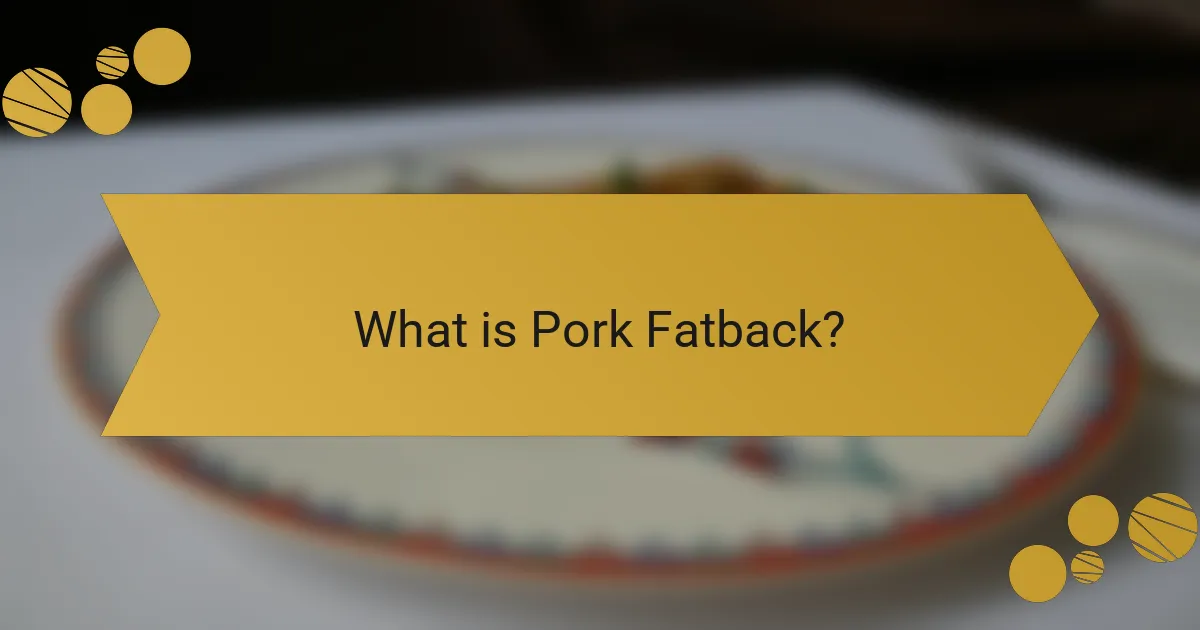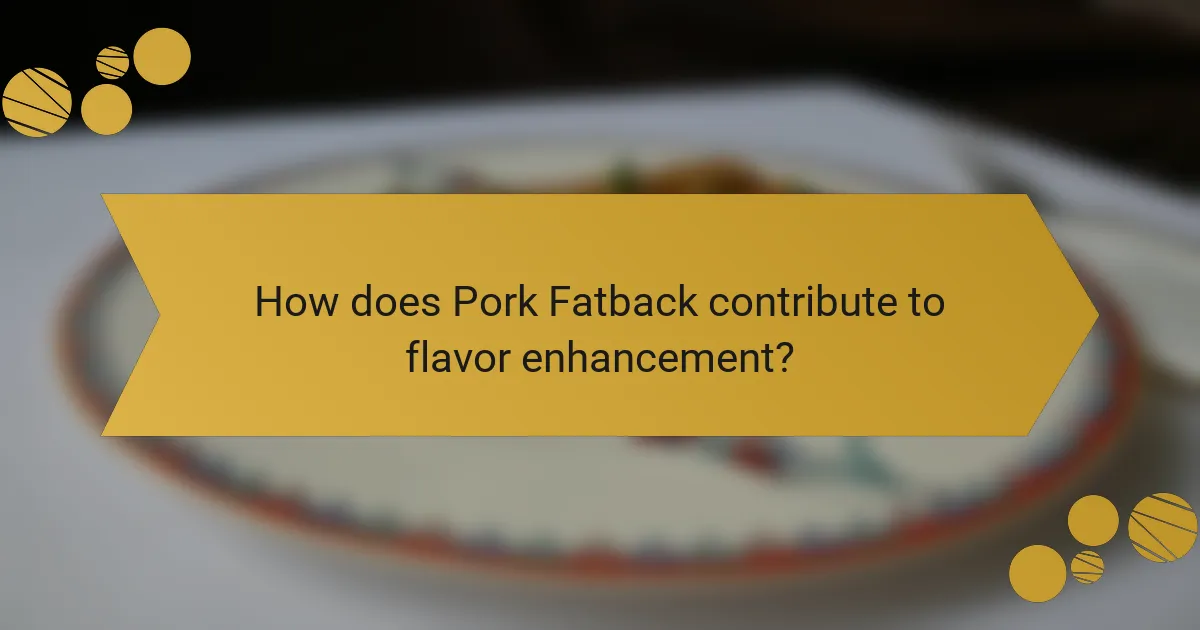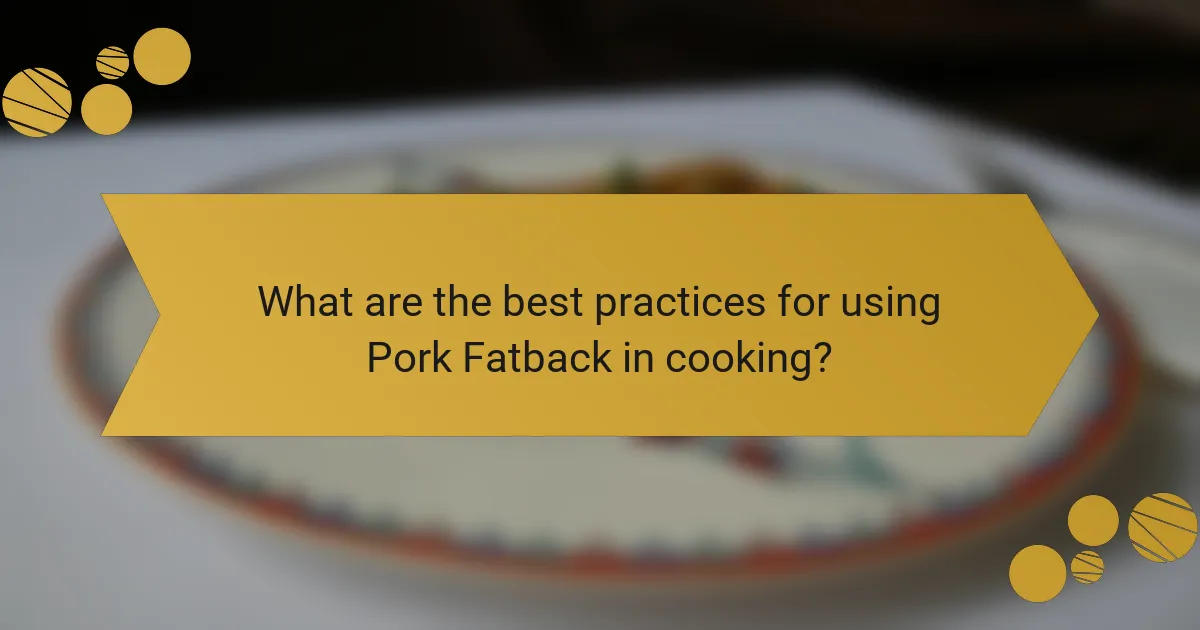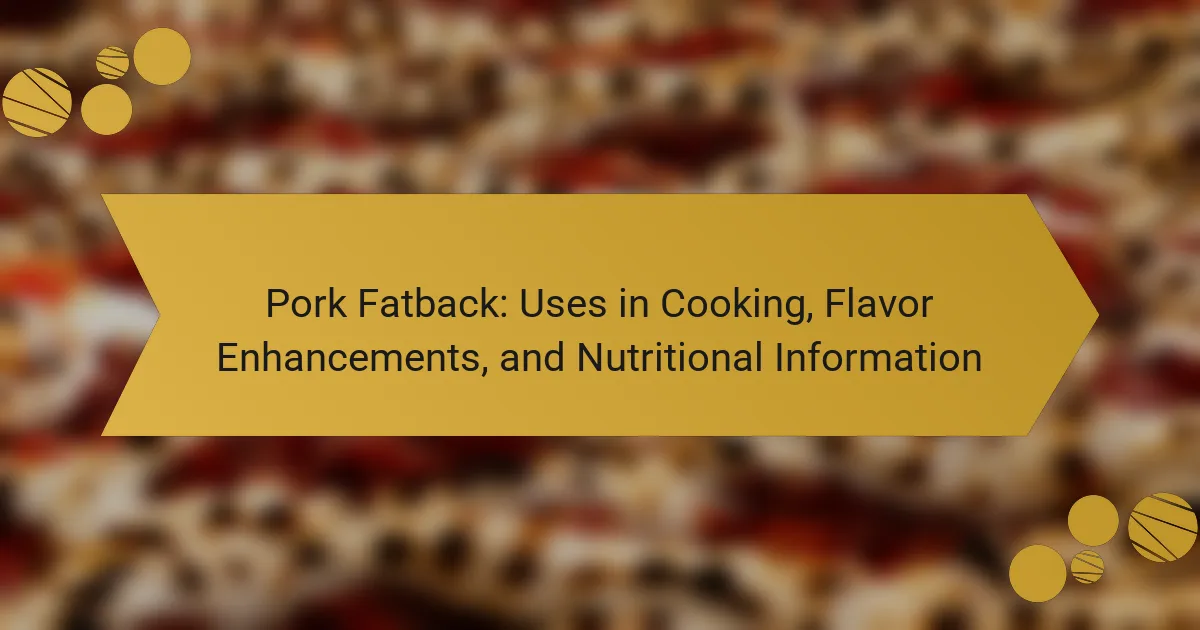
What is Pork Fatback?
Pork fatback is a cut of pork that comes from the back of the pig. It consists primarily of fat, with a thin layer of meat. This cut is known for its high-fat content, which can enhance flavor in various dishes. Pork fatback is often used in cooking to add richness and moisture. It is commonly used in sausages, pâtés, and as a flavoring agent in stews. The fat can also be rendered to produce lard, which is a versatile cooking fat. Historically, fatback has been utilized in many cuisines for its ability to improve texture and taste.
How is Pork Fatback sourced and processed?
Pork fatback is sourced from the back of pigs, specifically the layer of fat beneath the skin. This fat is typically harvested during the butchering process. After slaughter, the pig is cleaned and the fatback is cut away from the carcass. The fatback is then trimmed to remove any meat or connective tissue.
Processing involves curing or rendering the fat for preservation and flavor enhancement. Curing can include the application of salt and spices, allowing the fat to develop a richer flavor. Rendering involves melting the fat to separate it from any impurities, creating lard.
The final product can be used in various culinary applications, providing moisture and flavor to dishes. Pork fatback is valued for its high-fat content, which can reach up to 80%.
What are the characteristics of high-quality Pork Fatback?
High-quality pork fatback is characterized by its firm texture and creamy white color. It should have a smooth surface without blemishes or discoloration. The fatback should possess a rich, porky flavor, which enhances dishes when used in cooking. High-quality fatback typically comes from well-fed pigs, contributing to its superior taste and texture. The fat content should be consistent, with a good balance of meat and fat layers. Freshness is crucial; it should have a clean smell without any off-putting odors. Proper marbling is also a sign of quality, indicating the presence of intramuscular fat that enhances flavor.
How does the processing method affect the flavor of Pork Fatback?
The processing method significantly influences the flavor of pork fatback. Different methods such as curing, smoking, or rendering create distinct taste profiles. Curing enhances the umami flavor, while smoking adds a rich, smoky taste. Rendering fatback produces a milder flavor, suitable for cooking or baking. Each processing technique alters the fat’s chemical composition, impacting its flavor release during cooking. For instance, smoked fatback tends to impart a deeper flavor to dishes. Cured fatback can also provide a savory depth, enhancing overall dish complexity.
What culinary uses does Pork Fatback have?
Pork fatback is used primarily for adding flavor and moisture to dishes. It is often incorporated into sausages, providing richness and enhancing texture. Additionally, pork fatback can be rendered into lard, which is used for frying and baking. It is also used in traditional dishes like collard greens, where it imparts a savory taste. In charcuterie, pork fatback is essential for making pâtés and terrines. The fatback can be cured or smoked, which adds complexity to its flavor profile. Its high-fat content makes it a key ingredient in many rustic recipes.
How can Pork Fatback enhance the flavor of various dishes?
Pork fatback enhances the flavor of various dishes by adding richness and depth. The high-fat content contributes to a savory, umami taste. It can be rendered down to create flavorful lard for cooking. This lard imparts a distinct pork flavor to dishes like beans and stews. Additionally, fatback can be used as a seasoning agent in sausages. It helps to keep the meat moist during cooking. In traditional recipes, fatback is often incorporated into collard greens or other vegetables. This method infuses the dish with a hearty taste profile.
What traditional recipes utilize Pork Fatback?
Traditional recipes that utilize Pork Fatback include Southern collard greens, where fatback adds richness and flavor. It is also used in traditional Italian pasta dishes like Amatriciana, contributing to the sauce’s depth. In Cajun and Creole cooking, fatback is often found in gumbo for added fat and flavor. Additionally, it is used in making traditional sausages, enhancing moisture and taste. Fatback is integral to regional dishes like feijoada in Brazil, where it provides essential flavor. These recipes highlight the versatility of fatback in various cuisines.
What are the nutritional aspects of Pork Fatback?
Pork fatback is high in fat content, primarily composed of saturated fats. A 100-gram serving contains approximately 80 grams of total fat. This includes about 30 grams of saturated fat, which is significant for dietary considerations. Pork fatback also provides around 900 calories per 100 grams. It contains minimal protein, roughly 1.5 grams, and negligible carbohydrates. Additionally, it is a source of vitamins, particularly vitamin D and some B vitamins. The high fat content can contribute to energy density in meals.
What essential nutrients are found in Pork Fatback?
Pork fatback contains essential nutrients such as fats, proteins, and vitamins. It is particularly high in saturated fats, which provide energy. Additionally, pork fatback contains monounsaturated fats beneficial for heart health. The protein content supports muscle maintenance and repair. It also includes fat-soluble vitamins like vitamin A, which is important for vision and immune function. Furthermore, pork fatback provides small amounts of B vitamins, including B12, which is crucial for nerve function and red blood cell formation. These nutrients contribute to the overall nutritional profile of pork fatback.
How does the fat content in Pork Fatback compare to other cooking fats?
Pork fatback contains approximately 99% fat, making it one of the fattiest cooking fats available. In comparison, butter has about 81% fat content, while olive oil contains around 100% fat but is primarily unsaturated. Lard, another cooking fat, typically has about 100% fat content as well. This high fat percentage in pork fatback contributes to its rich flavor and cooking properties. The specific composition of fat in pork fatback includes a mix of saturated and unsaturated fats, similar to lard but differing from oils like olive oil, which is mainly unsaturated. This distinct fat profile makes pork fatback a unique option in culinary applications, particularly for flavor enhancement in dishes.

How does Pork Fatback contribute to flavor enhancement?
Pork fatback enhances flavor through its rich, fatty content. This fat provides a savory, umami taste that deepens the overall flavor profile of dishes. When cooked, pork fatback renders down, releasing its flavors into surrounding ingredients. This process creates a luxurious mouthfeel and richness. Fatback is commonly used in sausages, where it adds moisture and prevents drying. It also acts as a flavor carrier, helping to distribute spices and seasonings evenly. The high-fat content can balance out acidity in recipes, creating a more harmonious taste. Cooking with pork fatback is a traditional technique in many cuisines, showcasing its effectiveness in flavor enhancement.
What techniques can be used to incorporate Pork Fatback into cooking?
Pork fatback can be incorporated into cooking through several techniques. Rendering is a common method, where fatback is slowly cooked to extract fat, creating lard for frying or baking. Dicing fatback into small pieces allows it to be used as a flavor enhancer in soups, stews, and braises. It can also be used to wrap lean meats, adding moisture and richness during cooking. Additionally, fatback can be cured and sliced thin for use in sandwiches or as a topping. These techniques enhance the flavor profile of various dishes.
How does rendering Pork Fatback improve its flavor profile?
Rendering pork fatback significantly enhances its flavor profile. This process involves melting the fat, which releases flavorful compounds. The heat breaks down connective tissues, resulting in a richer taste. Additionally, rendering allows for the removal of impurities, leading to a cleaner flavor. The resulting lard can be used in various dishes, adding depth and richness. Studies show that rendered pork fat contains flavor compounds like oleic acid, which contribute to its savory profile. Overall, rendering transforms pork fatback into a versatile ingredient that elevates culinary dishes.
What is the role of Pork Fatback in creating rich sauces?
Pork fatback plays a crucial role in creating rich sauces by providing a deep, savory flavor and enhancing texture. Its high-fat content contributes to a velvety mouthfeel in sauces. When rendered, pork fatback releases flavorful oils that serve as a base for various sauces. This fat also helps to emulsify sauces, allowing for a smooth consistency. Additionally, the natural flavors in pork fatback can elevate the overall taste profile of a dish. Many traditional recipes utilize fatback for its ability to add depth and richness. This use is supported by culinary practices that highlight fat as a key ingredient in sauce-making.
Why is Pork Fatback considered a versatile ingredient?
Pork fatback is considered a versatile ingredient due to its high fat content and unique flavor profile. It can be used in various cooking methods, including roasting, frying, and braising. The fatback adds moisture and richness to dishes, enhancing overall flavor. It is often used in charcuterie for making sausages and pâtés. Additionally, pork fatback can be rendered into lard, which serves as a cooking fat. Its ability to complement both savory and sweet recipes further demonstrates its versatility. Historically, fatback has been a staple in many cuisines, showcasing its adaptability in different culinary traditions.
What types of cuisines benefit most from using Pork Fatback?
Southern cuisine, particularly in the United States, benefits most from using pork fatback. Pork fatback is often used in dishes like collard greens and cornbread. It adds richness and flavor to these traditional recipes. Additionally, Italian cuisine utilizes pork fatback in preparations like guanciale. Guanciale is made from pork cheek or jowl but often incorporates fatback for enhanced flavor. In Eastern European cooking, pork fatback is used in various cured meats and sausages. These cuisines leverage the high-fat content of fatback for taste and texture.
How does Pork Fatback compare to other types of animal fats in cooking?
Pork fatback is a type of animal fat that is primarily used for flavoring and enhancing dishes. It has a high fat content, which provides a rich and savory taste. Compared to other animal fats like lard or beef tallow, pork fatback has a milder flavor profile. This makes it versatile for various cooking methods, including frying and roasting.
In terms of texture, pork fatback renders down easily, creating a crispy texture when cooked. This is similar to how lard behaves but differs from beef tallow, which can have a stronger flavor. The melting point of pork fatback is lower than that of beef tallow, allowing it to incorporate more seamlessly into dishes.
Pork fatback also contains a higher level of unsaturated fats compared to beef tallow. This can make it a slightly healthier choice in moderation. It is often used in traditional recipes, such as sausages and pâtés, where its flavor and fat content enhance the overall dish.
In summary, pork fatback offers a unique combination of flavor and texture that sets it apart from other animal fats in cooking.

What are the best practices for using Pork Fatback in cooking?
Pork fatback is best used for adding flavor and moisture to dishes. It can be rendered to make lard, which enhances the taste of baked goods. When using pork fatback, cut it into small pieces for even rendering. Cooking it slowly over low heat prevents burning and allows the fat to melt properly. Incorporating it into stews or braises provides rich flavor. It can also be used to wrap lean meats, adding moisture during cooking. Storing pork fatback in the refrigerator extends its freshness for several weeks. For long-term storage, freezing is recommended.
How can one properly store Pork Fatback?
To properly store pork fatback, wrap it tightly in plastic wrap or aluminum foil. This prevents exposure to air, which can cause spoilage. Place the wrapped fatback in an airtight container or a resealable plastic bag. Store it in the refrigerator if using within a week. For longer storage, freeze the fatback. It can be kept in the freezer for up to six months without significant loss of quality. Always label the container with the date of storage for reference. Proper storage helps maintain freshness and flavor.
What are the signs of spoiled Pork Fatback?
Signs of spoiled Pork Fatback include a sour or off smell. Fresh Pork Fatback should have a mild, pork-like aroma. Discoloration, such as a gray or green tint, indicates spoilage. The texture may become slimy or sticky when fatback is spoiled. Additionally, the presence of mold is a clear sign of spoilage. If the fatback feels excessively soft or mushy, it is likely no longer safe to consume. These indicators help ensure food safety when handling Pork Fatback.
How long can Pork Fatback be stored without losing quality?
Pork fatback can be stored for up to six months in the freezer without losing quality. When stored properly in an airtight container or vacuum-sealed, it maintains its flavor and texture. Refrigeration allows for a shorter storage time of about one week. After this period, the quality may decline, affecting taste and usability. Proper storage methods are crucial for preserving its characteristics.
What tips can enhance the cooking experience with Pork Fatback?
To enhance the cooking experience with Pork Fatback, use it to add flavor and moisture to dishes. Rendering the fatback before use allows you to extract flavorful lard for cooking. This lard can be used for frying or sautéing, enhancing the taste of vegetables and meats. Incorporating diced fatback into recipes like stews or beans adds richness and depth. Pairing it with herbs and spices can elevate the overall flavor profile. Cooking fatback slowly helps to render the fat and tenderize the meat, making it more palatable. Additionally, using it in moderation balances the dish while still providing the desired flavor.
How can one balance the richness of Pork Fatback in recipes?
To balance the richness of pork fatback in recipes, incorporate acidic ingredients such as vinegar or citrus juice. These acids can cut through the fat’s richness, enhancing the overall flavor profile. Additionally, using fresh herbs and spices can add complexity and freshness to the dish. Pairing pork fatback with vegetables like greens or tomatoes can also help balance its richness. Cooking methods such as braising or roasting can render some fat, reducing its intensity. Finally, serving pork fatback in smaller portions allows for a more balanced meal.
What common mistakes should be avoided when cooking with Pork Fatback?
Common mistakes to avoid when cooking with pork fatback include not rendering the fat properly. Rendering is essential to achieve the desired texture and flavor. Overcooking can also lead to an unpleasant, greasy taste. It’s important to monitor cooking times closely. Using too high heat can cause the fat to burn, ruining the dish. Additionally, underestimating the seasoning is a mistake. Pork fatback can be bland without adequate spices. Finally, not allowing the fatback to rest after cooking can lead to loss of moisture and flavor. Proper resting enhances the overall taste experience.
Pork fatback is a high-fat cut from the back of the pig, primarily used in cooking for its ability to enhance flavor and moisture in various dishes. The article explores the sourcing and processing of pork fatback, highlighting its characteristics, culinary uses, and nutritional aspects. It details how different processing methods, such as curing and rendering, affect flavor profiles and discusses traditional recipes that incorporate fatback. Additionally, it provides best practices for storage, cooking techniques, and tips for balancing its richness in recipes.
